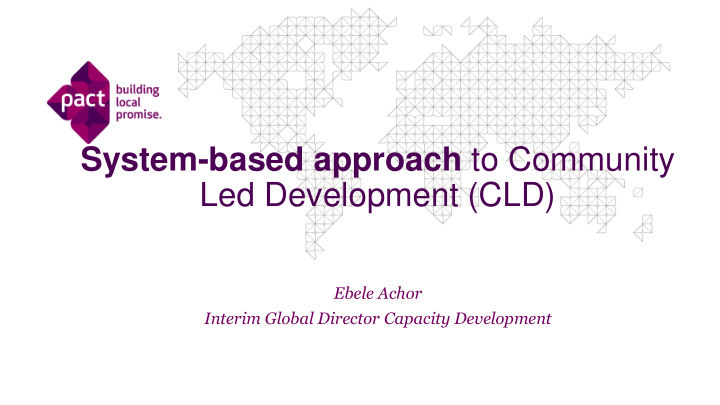



System-based approach to Community Led Development (CLD) Ebele Achor Interim Global Director Capacity Development
Pact since 1971 , in nearly 40 countries, about 5,000 employees globally - striving for a world where everyone owns their future and all people are heard, capable and vibrant Where we work? What we do? Integrated Development : Health; Livelihoods and Economic Opportunities; Capacity Development; Governance; Business and Markets; Orphans and Vulnerable Children; Natural Resource Management
Global trends driving increased focus on CD 1. Zeal for direct granting to indigenous 5. Global expectations for measurable, at organizations scale outcomes. 2. Decentralization 6. Private Sector engagement for 3. Recognition of the efficacy of localized development solutions 4. Closing space for civil society worldwide
Capacity Development at Pact • Is a continuous process, an approach, and an outcome (not isolated events) • Must be stated and intentional • Is MUCH more than knowledge transfer: it’s co-creation, co- implementation • Should creatively use technology • Recognizes complex adaptive systems • Is necessary for sustainability
OPI Endorsed by USAID in 2015
Thinking Systems-based approach
We Understand that: • Communities are complex adaptive systems made up of numerous sub-parts • These parts are connected, driven by some purpose, follow certain rules, and interact with each other and with their surrounding environment.
Source: USAID
We believe that… Sustainable Impact Change in Org. Capacity Improved Improved internal systems development performance and processes outcome interventions s Improved service delivery Change in capacities of the system that System based Improved enables access Every interaction is an interventions “local system” opportunity. We use tools performance & processes that focus on: • Systems thinking • Co-creation • Adaptive management • Sustainability
Individual people Capacity 2.0 framework • Systems thinking / Complexity theory and tools • Collective Impact Approach Orgs, • Many tools, extensive evidence base entities, • Co-creation institns • Adaptive management • Convening / facilitation • Inclusion System • Engagement / relationship building Sustainable Levels of capacity: selected theories, Development approaches, and Results tools to affect them
“In Capacity 2.0, we… Source: USAID 1. Examine how an organization fits in with other elements that create the greater local system 2. Co-select partners based on this broad analysis of the system and how helping the partner perform better will matter 3. Act as mentors and coaches to help partners understand how best to achieve their desired performance. 4. Promote the importance of connections, communication, 4. social capital, and “best fit” approaches
“What we do in Capacity 2.0… (continued) 5. Enable partners to determine the desired performance and the best path to achieve it within their organizational context 6. Focus on recipient learning, adaptation and self-renewal 7. Measure performance instead of assessing capacity - We measure what the organization is actually accomplishing instead of its potential for action.”
What is Collective Impact ? An “operating system for social and systems change.” What it offers, as presented by Stanford University Center for Social Innovation…
Five elements of Collective Impact 1. Common agenda/shared understanding — All partners have a shared vision for progress that includes a common understanding of the problem and a joint approach to solving the problem through agreed upon actions. 2. Mutually reinforcing/highest leverage activities – Anchor infrastructure (aka backbone infrastructure) – Engagement of a diverse set of stakeholders(including beneficiaries) typically across sectors, coordinating a set of differentiated activities through a mutually reinforcing plan of action. 3. Shared measurement, learning, and adaptation — Agreement on the ways success will be measured and reported by all partner organizations 4. Continuous engagement — Communications over a long period of time among key players within and across organizations, to build trust and inform learning and adaptation of strategy. 5. Backbone Organization — Ongoing support provided by a chosen partner, within the cohort, to move the group’s initiatives forward. forward
Source: Kania, Water of Systems Change
Netmapping Some other systems- Co-creation informed Capacity Adaptive management Development ideas and tools Lean experimentation Systems-level capacity development
Food for Thought • With a shift to measurement at the system and network level, how do we measure impact and sustainability? • Stakeholder buy-in is often in the implementation of systems-based approaches, what successful models have been used to address this challenge? • What else can we measure that get’s at system level change?
Connect with us • Ebele Achor: eachor@pactworld.org • Sarah Kosling: skoslingo@pactworld.org • Saraounia Mboka-Boyer smbokaboyer@pactworld.org
Recommend
More recommend